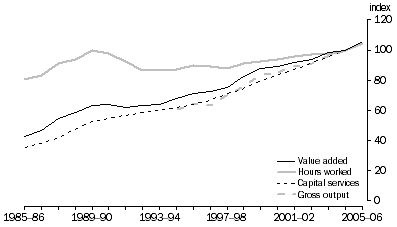OUTPUT
There are a range of conceptual issues underlying the output indicators in the Finance & insurance industry. First and foremost is identifying what it is that should be measured as output in the Finance & insurance industry and measuring the volume of this output.
The Finance & insurance industry provides a set of relatively intangible services. In the Finance segment of the industry the range of services includes providing a place to deposit money, providing access to credit, and providing financial advice and management services. The prudential services of the Insurance industry are equally hard to quantify. Moreover, the services across the industry are not homogenous nor directly comparable (though they may be more homogenous than the services of some other industries such as Cultural & recreational services).
13.2 Finance & insurance outputs and inputs, (2004-05 = 100)

Gross output in the Finance industry is derived as the sum of financial intermediation services indirectly measured (FISIM), explicit service charges and gross rents of banks and other finance institutions. FISIM is basically calculated as the earnings by financial firms from the differential between the interest paid on deposits held at the firm and the interest earned on loans provided by the firm. Output in the Insurance industry is derived as the sum of premiums collected and investment income earned by insurance companies less claims paid. In both cases, value added is derived by deducting intermediate consumption from gross output.
While these definitions are useful for describing the value of output, there remains a lack of clarity in the description of the volume of output from the Finance & insurance industry. Whereas it is generally feasible to measure the value of the output in current prices, deflating the indirectly measured components of this output to a volume measure is problematic because a price change between the two periods is not readily identifiable (more information can be obtained from Australian System of National Accounts: Concepts, Sources and Methods, chapter 10, cat.no. 5216.0).
The period around 1989-90 was a period of significant transition and readjustment for the Finance & insurance industry. During this period, the banking industry experienced losses that were equivalent to 2.3% of GDP in 1989-90 (Gizycki and Lowe 2000). In volume terms value added growth slowed in 1990-91 and fell in 1991-92 by 3.8%. This decline in output had followed a period of significant deregulation in the 1980s that had intensified competition in the Australian finance industry. Through this period, a property price bubble was also expanding quickly. However, the recession of the early 1990s saw a significant slowdown in housing market activity, resulting in an associated fall in Finance & insurance industry value added. footnote 1
One of the most notable changes in the Finance & insurance industry in more recent years has been the introduction of new electronic banking and finance services. Compared to twenty years ago when withdrawals and deposits were usually done through a teller, today they are frequently made electronically through an ATM, over the internet, or at the point of sale using EFTPOS. Also, twenty years ago bank transfers were carried out in a branch, whereas today they can be carried out over the internet. In addition, specialised brokers generally facilitated trading in shares twenty years ago, today people are able to quickly and easily access the market through the internet. Technological changes may have enabled banks to achieve both economies of scale and scope, although much of the evidence is anecdotal.
1 Gross operating surplus in current prices fell by around 25 per cent in 1989–90. back
 Print Page
Print Page
 Print All
Print All